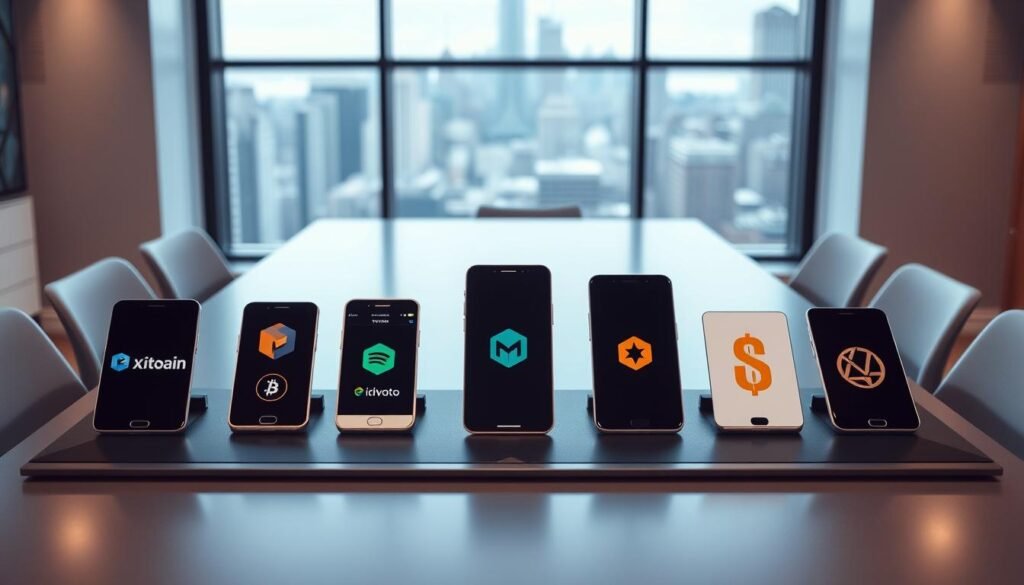
Best Crypto Trading Apps USA Safe Platforms: Top Choices

You want to open an account, fund it, and place your first trades with confidence today.
Think of a friend who downloaded Coinbase to buy a few coins, then found the fee chart confusing. They switched to Gemini for the tutorials, then glanced at Kraken and Crypto.com for a wider coin menu.
This story shows the choices you face: clear fees, coin selection, fast withdrawals, and ways to secure your assets.
In this guide you’ll compare who leads on listings (Kraken, Crypto.com, Coinbase Exchange), where fees start, and which services offer staking or capped commissions like Interactive Brokers.
Follow simple steps in the process create an account, enable 2FA, fund by ACH, then buy or sell—so your first trades feel routine, not risky.
- Why you’re here: secure, U.S.-ready crypto apps that you can trust today
- Editor’s top picks: safe cryptocurrency apps and exchanges for U.S. users
- Safety first: how U.S. crypto platforms protect your assets
- Fees that actually matter: trading, spreads, deposits, and withdrawal costs
- Which platforms offer the most cryptocurrencies?
- Customer support you can actually reach
- Trading experience: from beginner-friendly apps to pro-grade terminals
- Wallets and storage: should you keep coins on the app?
- Getting started today: how to open, fund, and place your first trade
- Brokers vs. exchanges: which route fits your goals?
- Best for beginners: low-fee, easy-to-use apps with strong education
- Best for active traders: low costs, liquidity, and advanced features
- Availability in the United States: state-by-state considerations
- best crypto trading apps USA safe platforms
- Key factors to compare before you download any app
- Avoid common pitfalls: volatility, fee surprises, and risky storage habits
- Your next step: pick a platform, secure your account, and start small
Why you’re here: secure, U.S.-ready crypto apps that you can trust today
You want an app that turns fiat into coins without a maze of extra steps or hidden charges. Centralized exchanges are usually the quickest route when you start from a bank account because a company handles custody, compliance, and fiat rails for you.
Decentralized options offer peer-to-peer swaps but assume you already hold cryptocurrencies and know wallet mechanics. For most beginners, that adds friction and extra risk.
Customer support varies widely. Pure-play exchanges sometimes trail traditional brokerages on response times, so check which providers offer phone, chat, or email help and read real user notes on response speed.
- Look for U.S.-ready features: ACH deposits, USD withdrawals, and clear ID verification paths.
- Prioritize transparent fees and simple onboarding that highlights portfolio, buy/sell actions, and order types.
- Choose a provider that bundles education glossaries, how-tos, and short tutorials so you can learn without hunting forums.

Editor’s top picks: safe cryptocurrency apps and exchanges for U.S. users
When you compare options side by side, differences in fees, listings, and security jump out. Below is a concise guide to help you match features to your goals. Think about coin variety, fee tiers, and withdrawal policies first.
Kraken 400+ coins; maker/taker tiers start at 0.25%/0.40% for low volumes and strong security tools.
Coinbase 290+ listings on Coinbase Exchange, fast withdrawals, low funding minimums, and robust educational resources for beginners.
Gemini 70+ coins, 0.20%/0.40% maker/taker for small volumes, NYDFS oversight, and a clear mobile experience.

| Provider | Number coins | Starter fees | Notes |
|---|---|---|---|
| Kraken | 400+ | 0.25% maker / 0.40% taker | Broad listings, strong security |
| Coinbase Exchange | 290+ | 0.40% / 0.60% | Fast withdrawals, strong education |
| Crypto.com | 400+ | 0.25% / 0.50% | Staking perks; watch withdrawal fees |
| Binance.US | 160+ | 0.10% / 0.10% | Low fees for regular users |
Other options like Uphold, Interactive Brokers, Gemini, Fidelity Crypto, Robinhood/Bitstamp, and eToro each fill different needs thousands of pairs, capped commissions, or simple app flows. Weigh withdrawal fees, supported coins, and available customer support before you buy or sell.
Safety first: how U.S. crypto platforms protect your assets
Before you move funds, know how a platform protects accounts and where that protection stops. SIPC insurance does not apply to cryptocurrency, so you can’t assume the same civil protections you get with a stock broker.
What investor protections do and don’t cover
You should assume SIPC doesn’t cover your holdings. If an exchange fails or is hacked, reclaiming value can be difficult. That means your plan must focus on preventing account compromise and limiting exposure.

- Enable two-factor authentication and use unique, strong passwords to reduce account-level risk.
- Turn on withdrawal confirmations and allowlisting of addresses so funds can’t leave without extra checks.
- Check that the exchange keeps most customer assets in cold storage and uses strong encryption for data in transit and at rest.
- Consider moving long-term holdings to a self-custody wallet and keeping only an active balance for trading needs.
- Maintain device hygiene: install OS updates, use a reputable password manager, and avoid phishing links aimed at your login.
Tip: Compare security pages and past incident responses. Look for support of hardware keys, session alerts, and clear status reports. When you combine platform safeguards with careful habits, you can more safely use crypto while protecting your assets.
Fees that actually matter: trading, spreads, deposits, and withdrawal costs
What you pay depends on how you place orders, where you move fiat, and which exchange model you use.
Maker/taker fee structures vs. spreads: Some venues list maker/taker rates (Kraken 0.25%/0.40% under $10k, Coinbase Exchange 0.40%/0.60%, Binance.US 0.10%/0.10%). Others use an all-in spread (Uphold, eToro), or flat asset fees for certain cryptocurrencies.
Funding and withdrawal fees
Factor ACH or wire charges, network gas, and minimum withdrawal amounts. Crypto.com often offers low cash transfers but high crypto withdrawal fees and minimums that can trap small balances.
Advanced users: volume tiers
Higher 30-day volume reduces fees on tiered exchanges like Kraken, Coinbase, Crypto.com, and Gemini. Interactive Brokers uses low commissions (0.12%–0.18%) with caps that help large trades.
Quick checklist
- Compare maker/taker vs. spread for your typical order size.
- Use limit orders to capture maker pricing when spreads are tight.
- Track non-trading costs: deposit, wire, and withdrawal fees.
| Provider | Starter maker/taker | Notes on non-trading fees | Good for |
|---|---|---|---|
| Kraken | 0.25% / 0.40% | Standard network withdrawals | Frequent trades |
| Coinbase Exchange | 0.40% / 0.60% | Low funding minimums | Beginners |
| Binance.US | 0.10% / 0.10% | Competitive maker/taker | Active traders |
| Uphold / eToro | Spread or flat fees | Higher asset-based fees for BTC/ETH | Simple buys |
Which platforms offer the most cryptocurrencies?
Platforms differ widely in how many tokens they list; that choice affects research and liquidity.
For the deepest altcoin menus, look at providers that list hundreds of coins. Kraken and Crypto.com each show 400+ coins, giving you broad exposure to niche projects.
Coinbase Exchange sits near the middle with roughly 290+ listings. Binance.US and Gemini offer more curated choices about 160+ and 70+, respectively. Those can be enough if you plan to focus on well-known projects.
- Wide catalogs: Kraken, Crypto.com 400+ number coins for exploration.
- Broad but focused: Coinbase Exchange ~290+ cryptocurrencies available.
- Curated lineups: Binance.US (160+), Gemini (70+).
- Brokerage lists: Fidelity Crypto (BTC, ETH, LTC); Interactive Brokers (BTC, ETH, LTC, BCH).
Tip: Confirm the exact number of listings before you open an account, especially if you track a niche token. More coins means more due diligence and potential liquidity issues.
| Provider | Number coins | Notes |
|---|---|---|
| Kraken | 400+ | Deep altcoin menus; good for broad research |
| Crypto.com | 400+ | Large selection; staking and promos may vary |
| Coinbase Exchange | 290+ | Wide listings with strong onboarding resources |
| Binance.US | 160+ | Curated but competitive liquidity for many pairs |
| Gemini | 70+ | Streamlined selection focused on mainstream projects |
Customer support you can actually reach
When support matters, you want answers fast and clear, not hold music and canned replies.
Live chat, phone lines, and response times: what to expect
Many pure exchanges still lack phone lines and can be slow to respond. NerdWallet notes that traditional brokerages tend to do better here.
Practical checks:
- Confirm which channels an app offers: live chat, phone, email, or ticketing, and whether they run 24/7.
- Interactive Brokers, for example, is known for stronger customer help; some pure-play venues may not list phone support.
- Read recent user reviews for account lockouts, KYC delays, and urgent withdrawal handling.
- Send a quick inquiry before funding large sums to test speed and clarity.
- Keep documents current and match bank info to reduce back-and-forth with agents.
| Provider | Channels | Notes |
|---|---|---|
| Interactive Brokers | Phone, chat, email | Strong 24/7 options for active users |
| Uphold | Chat, tickets | Support can lag during outages |
| Typical pure-play exchange | Chat, email | May lack phone support; response times vary |
Tip: Favor platforms that publish status pages and escalation paths so you know where to go when time matters.
Trading experience: from beginner-friendly apps to pro-grade terminals
Your trading interface sets how quickly you learn order mechanics and how precise your fills will be.
Exchanges function much like online brokerages: they offer multiple order types, execution tools, and risk controls that shape your day-to-day experience.
Core order types: market, limit, stop, and stop-limit
Control matters. Use market orders for speed and limit orders to lock a price. Stop and stop-limit options help cap losses or protect gains.
These choices let you manage price, timing, and risk rather than relying on instant buys. Practice small fills to learn how each behaves in fast markets.
Pro tools: depth charts, advanced routing, and futures access
When you reach a higher level, look for depth charts, order books, and conditional orders. Some platforms add TWAP/VWAP routing and futures where permitted.
Customize layouts, hotkeys, and default sizes to speed execution and cut mistakes. Always check confirmations so you know fees and slippage for each trade.
- Begin with a simple view; switch to pro mode as you gain confidence.
- Confirm whether the platform offers derivatives and match leverage to your experience level.
Wallets and storage: should you keep coins on the app?
Deciding where to hold your cryptocurrency is a security choice, not just a convenience one.
Keeping a small balance on an exchange can speed deposits and let you act quickly when markets move. Many exchanges store most customer funds in cold storage and require two-factor authentication plus withdrawal confirmations. That lowers risk, but it does not remove it.
Self-custody gives you control. A software wallet is convenient for regular use. A hardware wallet keeps private keys offline for long-term holdings. Multi-signature setups add shared approval for large transfers, reducing single-point-of-failure risk.
Follow a clear storage plan: back up seed phrases offline, test recovery, and separate hot wallets for active use from cold wallets for savings. Enable allowlisting and withdrawal confirmations on the exchange to cut exposure. Periodically move excess assets to your hardware wallet so your trading balance stays minimal.
- Keep only trading funds on an exchange; move long-term holdings to self-custody.
- Choose hardware wallets for offline protection and software wallets for daily use.
- Use multi-signature for shared or high-value accounts.
- Back up and test seed phrase recovery; store it offline and secure.
| Storage Type | Use Case | Key Advantage |
|---|---|---|
| On-exchange custody | Active orders, quick withdrawals | Convenience; 2FA and cold storage policies |
| Software wallet | Frequent small transfers | Easy access; mobile and desktop options |
| Hardware wallet | Long-term holdings | Offline private keys; strong theft resistance |
| Multi-signature | Shared or corporate custody | Requires multiple approvals; reduces single-point risk |
Getting started today: how to open, fund, and place your first trade
Begin with identity verification and basic security so your first buy happens on an account you control.
Account setup and KYC: Download the app, create an account, and provide your name, date of birth, address, Social Security number, and a government ID photo for verification. Many venues have no account minimums and allow very small purchases.
Security hygiene
Enable a strong, unique password and turn on 2FA with an authenticator app. Add withdrawal confirmations and address allowlisting before you deposit funds.
Deposits and your first buy
Fund by ACH or wire, check deposit limits and any holds, then place a small market or limit order to test the flow. Review the order confirmation for price, fees, and total cost.
After settlement, view your new balance and decide whether to keep some on the platform or move funds to a crypto wallet. Use educational resources to learn order types and repeat small practice trades until the process feels routine.
Brokers vs. exchanges: which route fits your goals?
You can pick a dedicated exchange or a traditional broker depending on how hands‑on you want to be.
Choose a centralized exchange if you want more pairs, advanced order types, and a crypto-first workflow. These venues act much like online brokerages for digital assets and support limit, stop, and conditional orders.
If you prefer to keep stocks and crypto together, brokers may suit you better. Firms like Interactive Brokers charge commissions in the 0.12%–0.18% range (capped up to 1%). Fidelity Crypto now supports BTC, ETH, and LTC and added send/receive in 2025, though it does not offer staking.
- When to pick an exchange: breadth of listings, lower maker/taker options, and advanced execution tools.
- When to pick brokers: familiar interface, stronger service channels, and easier fiat on‑ramps.
Compare costs, available cryptocurrencies, and whether you can send and receive funds. That helps you choose the best terms for frequent buy and sell activity or long‑term holds.
Best for beginners: low-fee, easy-to-use apps with strong education
A clear, guided experience helps you learn order types without feeling overwhelmed.
Kraken, Coinbase, and Gemini are common starting points for new users because each balances usability with education and controls.
Kraken shows transparent maker/taker pricing and lists 400+ coins, so you can start small and scale as your level rises.
Coinbase offers quick withdrawals, low minimums, and in-app tutorials that help you fund, buy, and confirm orders with confidence.
Gemini provides a clean, beginner-oriented interface and nationwide availability under NYDFS oversight, though fees can be higher than some exchange rivals.
- Check the fee estimate before each order and use limit orders when spreads widen to keep costs predictable.
- Rely on educational resources to learn wallets, security, and common mistakes before placing larger buys.
- Practice with small trades: deposit, buy, confirm, and withdraw until the workflow becomes routine.
Tip: Begin with mainstream cryptocurrencies available on these services, then expand your list once you feel comfortable with the platform and your experience grows.
Best for active traders: low costs, liquidity, and advanced features
If you plan to trade large volumes, execution quality and fee tiers will shape your net returns more than coin selection.
Kraken, Binance.US, and Coinbase Advanced lead when you need tight spreads, deep order books, and advanced order types.
Kraken lists 400+ coins and offers tiered maker/taker pricing (0.25%/0.40% under $10k). That helps if you chase many pairs and want volume discounts.
Binance.US supports ~160+ coins with 0.10%/0.10% maker/taker rates for regular users. Low fees plus fast matching reduce slippage on frequent trades.
Coinbase Advanced (Coinbase Exchange) starts at 0.40%/0.60% under $10k and adds pro tools, charting, and routing for deeper execution control.
- Prioritize deep liquidity, maker rebates, and low base fees during peak volume.
- Check API access, rate limits, and historical data if you automate or backtest.
- Run small live tests to measure slippage and realized fees across sessions.
| Exchange | Coins listed | Starter maker/taker | Pro features |
|---|---|---|---|
| Kraken | 400+ | 0.25% / 0.40% | Tiered fees, advanced order types |
| Binance.US | 160+ | 0.10% / 0.10% | Low fees, fast matching engine |
| Coinbase Advanced | ~290+ | 0.40% / 0.60% | Pro charting, routing, futures access |
Availability in the United States: state-by-state considerations
Your address can change which coins and services an exchange shows you, even if the app itself is available nationwide.
Some features and service access vary by state. Gemini offers accounts in all states, while traditional brokers like Fidelity and Interactive Brokers serve every state but list a smaller number of cryptocurrencies.
Before you sign up, confirm that the platform supports account opening and key services where you live. Check for staking, ACH deposits, and cash withdrawal rules tied to your state of residence.
- Review each provider’s help center for state lists and temporary suspensions.
- Verify residency rules and keep your profile updated after address changes.
- Plan travel: make sure your two-factor methods and phone number will still work away from home.
- Keep a secondary option ready in case your primary exchange limits certain coins or pauses services.
Tip: Lean on brokers for consistent geographic coverage if you prefer stable USD rails, and check customer support channels before moving funds.
best crypto trading apps USA safe platforms
You need a short, focused shortlist so you can match fees, coins, and support to your routine.
Top U.S.-ready choices: Kraken and Crypto.com offer deep menus (400+ listings) and tiered fees. Coinbase Exchange balances learning resources with quick withdrawals. Binance.US gives low base rates for active users. Gemini provides broad state availability and a clean app.
Consider brokers too. Interactive Brokers and Fidelity Crypto suit users who want consolidation with fewer cryptocurrencies and predictable commissions. Uphold and Bitstamp add flat-fee or simple spreads, while eToro lists a spread plus a modest service fee.
| Provider | Coins | Starter fees | Notes |
|---|---|---|---|
| Kraken | 400+ | 0.25% / 0.40% | Deep listings, strong security |
| Coinbase Exchange | 290+ | 0.40% / 0.60% | Education, fast withdrawals |
| Binance.US | 160+ | 0.10% / 0.10% | Low fees, high liquidity |
| Gemini | 70+ | 0.20% / 0.40% | Nationwide access, simple app |
Balance cost, coin access, ease of use, and support when you pick a service. Revisit this shortlist periodically fees and listings change as exchanges update their offers.
Key factors to compare before you download any app
Start with a short list of deal-breakers so you don’t chase every shiny coin listing.
Use a simple scorecard that weights what matters most to you. Forbes-style weighting favors available coins, fees, and security, but also counts customer sentiment and extras like staking or margin.
Supported coins and liquidity
Check coin lists first. Confirm your must-have coins are listed and that order books have enough volume for your size.
Fees and net cost
Compare fee types. Look at maker/taker rates, spreads, and withdrawal charges. Factor in volume tiers or loyalty programs that lower your effective fee.
Security, education, and sentiment
Review 2FA, withdrawal confirmations, cold storage claims, and any audit reports. Pair that with help centers and user reviews to gauge real-world support.
Rails, setup speed, and scorecard
Confirm ACH/wire support, KYC steps, and estimated response times for account issues. Then rate each exchange across these factors and sort by your top terms.
Avoid common pitfalls: volatility, fee surprises, and risky storage habits
Because values can change in minutes, size positions cautiously and rely on rules, not impulse. Short-term swings are normal, so treat each trade like a test of your process.
Watch execution and costs. Check the estimated charges before every order and compare maker/taker vs. spread pricing. Plan for network gas when you request a withdrawal so you don’t face surprise fees.
- You should keep mind that crypto prices swing quickly; avoid leverage until you gain experience.
- Avoid storing large balances on one exchange; move long-term holdings to your own wallet and test withdrawals with small amounts.
- Protect against phishing: bookmark official login pages, use a password manager, and never share 2FA codes.
- Set alerts and plan entries to stop rushed trades during illiquid hours.
- Document wallet backup and recovery steps so you can restore keys if a device is lost.
- Expect slower customer response during big market moves; keep IDs and bank details current to speed verifications.
Practice monthly checks. Run small security audits, review fees, and rebalance storage between hot and cold custody. That keeps your setup aligned with risk and helps you handle coins or cryptocurrencies without surprises.
Your next step: pick a platform, secure your account, and start small
Select a couple of providers that fit your goals, open an account on your top choice, and take it slow with a small deposit. ,
Shortlist two or three one exchange for broader coins and one broker for easy USD rails like Fidelity or Interactive Brokers. Fund by ACH or wire, then place a tiny first order to test the flow.
Secure your login on day one: use a strong password, 2FA app codes, withdrawal confirmations, and allowlisted addresses when available. Move long-term assets to a hardware wallet, back up your seed phrase, and test a small send/receive so the process works end-to-end.
Set simple routines: weekly learning, monthly fee checks, and quarterly security reviews. Scale as your confidence grows and keep a secondary option ready in case one service pauses or needs support.
If you want to know other articles similar to Best Crypto Trading Apps USA Safe Platforms: Top Choices you can visit the category Investing.






Leave a Reply